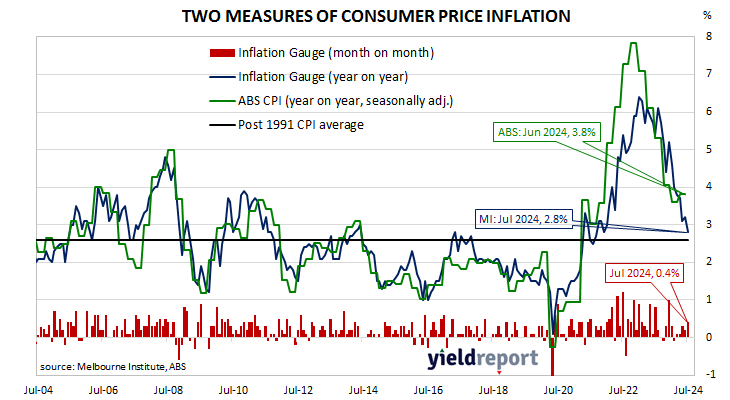Summary: Melbourne Institute Inflation Gauge index up 0.4% in July; up 2.8% on annual basis; ACGB yields plunge; rate-cut expectations harden, November cut priced in.
The Melbourne Institute’s Inflation Gauge is an attempt to replicate the ABS consumer price index (CPI) on a monthly basis. It has turned out to be a reliable leading indicator of the CPI, although there are periods in which the Inflation Gauge and the CPI have diverged for as long as twelve months. On average, the Inflation Gauge’s annual rate tends to overestimate the ABS rate by around 0.1%, or at least until recently.
The Melbourne Institute’s latest reading of its Inflation Gauge index indicates consumer prices increased by 0.4% in July, up from the increases of 0.2% and 0.3% posted in June and May respectively. However, inflation on an annual basis slowed from 3.2% to 2.8%.
Commonwealth Government bond yields generally plunged on the day, although ultra-long yields remained steady with a likely catch-up coming tomorrow. The falls followed large drops of US Treasury yields on Friday night and, by the close of business, the 3-year ACGB yield had lost 33bps to 3.31%, the 10-year yield had shed 19bps to 3.87% while the 20-year yield finished steady at 4.46%.
Expectations regarding rate cuts in the next twelve months hardened, with a November rate cut now pretty much priced in. In the cash futures market, contracts implied an average of 4.30% in August, 4.06% in November and 3.86% in February 2025. August 2025 contracts implied 3.34%, 100bps less than the current cash rate.
Central bankers desire a certain level of inflation which is “sufficiently low that it does not materially distort economic decisions in the community” but high enough so it does not constrain “a central bank’s ability to combat recessions.”


